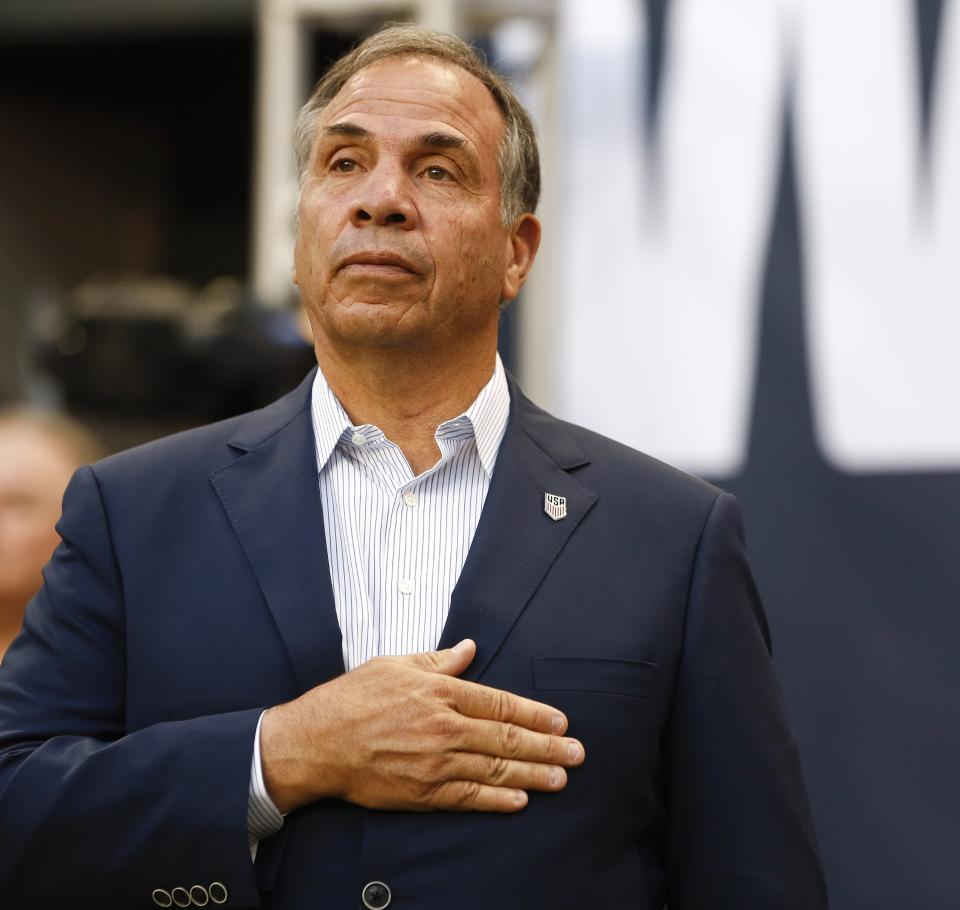We still don't really know how the USMNT should play, and that's a problem
It’s a problem that has vexed United States men’s national team managers for the better part of a decade. The enduring issue is a function of being a powerhouse within CONCACAF, but usually an underdog in competitive games against opponents from outside the region.
How should the Americans play?
On a fundamental level, what are the Yanks, soccer-wise?
Friday, Bruce Arena sent out an attacking team at home against Costa Rica in the resumption of World Cup qualifying. In Jozy Altidore, Bobby Wood and Christian Pulisic he fielded three out-and-out attackers, although the latter covers a lot of ground defensively as well. In his midfield, Darlington Nagbe is well-known as a one-way attacking distributor. Fabian Johnson clearly had an attacking assignment, although he was largely anonymous throughout — lacking in match fitness after an injury. And only Michael Bradley seemed to have a deep-sitting, shield-the-defense assignment, although he also spent a great deal of time building out of the back.
The USA chose possession, and positivity and attacking. And it got burned for it. Costa Rica set itself up to alternate between absorbing pressure and disrupting the American buildup high up the field and forcing errors. That’s how the Ticos induced sloppy mistakes and pounced. They took home a crucial 2-0 victory — the three points all but seeing them into next summer’s World Cup in Russia.
“They sat back in a back-five and hit us on the break,” said veteran goalkeeper Tim Howard, following the game. “We just weren’t good enough on the ball.”
[ Watch Tuesday’s USMNT-Honduras World Cup qualifier LIVE and for free on the go90 app ]
So what was the alternative? A more archaic approach consisting of a lump-it-forward defense and lots of long balls to a target man and/or an attacker trying to get in behind the defense, probably. A back line not burdened with passing assignments, and a midfield more concerned with closing gaps than nurturing the ball.
But both approaches are fraught for the Americans. While they simply had a bad night with several players performing below their level, there nevertheless remains a desperate shortage of players who are sufficiently efficient and comfortable on the ball to play for possession — especially in defense.
Playing a more direct — and perhaps cynical — kind of soccer doesn’t always work against Central American teams. Especially not at home, where all but Mexico are quite happy to get away with a tie.
The Costa Ricans deployed a 5-4-1 formation, screaming their reactive game plan from the rooftops.
“We could have lumped it forward but they had five guys in the back — a few monsters,” said Howard. “And they would have just headed it back down our throat. We tried to be patient, put them on the back foot a little bit.”
It didn’t work. It often doesn’t work.

Yet going back to Bob Bradley’s tenure as U.S. head coach, who succeeded Arena in 2006 and was himself replaced by Jurgen Klinsmann in 2011, the national team’s fans and observers yearned for a more pleasing playing style. While the U.S. made its name on sound defensive organization and athletic breakaways, that grew old. We wanted to see more passing, and more of the ball.
Klinsmann was hired specifically to accomplish that. But for his flaws as a coach and a public communicator, he also didn’t have the players to play that way. So he vacillated between styles and philosophies until he had failed his way out of a job. This remains the hangup. The U.S. still isn’t good enough to play a modern, high-press possession game. But its old bunker-and-bomb forward style doesn’t work against many of its regional opponents and is abhorred by its fans and critics.
So where does that leave you?
Needing results in all three of your final qualifiers in order to stay on track for the final berth to Russia, for one. And with no more room to get the approach wrong. In order to hang onto third place, with Mexico and Costa Rica out of reach, the Yanks will likely need a tie in Honduras on Tuesday and wins at home against Panama and away in Trinidad and Tobago next month.
Each of those games presents its own challenges. A scrappy Honduras will seek a home win — as it got four years ago in the same matchup of the last qualifying cycle — possibly opening up space for the Americans to play. Especially after sitting in during their first bout in San Jose, Calif., resulted in a cathartic 6-0 U.S. win over the Catrachos back in March. But now, as four years ago, they could quickly catch the Americans out on their mistakes.
An organized Panama team could frustrate the U.S. — as it did in this past summer’s Gold Cup. And a physical Trinidad and Tobago team will make for an inhospitable host in Port of Spain.
There is no obvious tactical answer for any of those games. Given the stakes and the narrow margins between three teams vying for one spot, it might have come time to get cynical and play for results. But then where is the progress of this aspirational age in American soccer?
In the late 1980s, U.S. Soccer began taking itself seriously again, after four decades of futility. Next summer, the Yanks hope to travel to an eighth straight World Cup, a feat that few countries can boast of. Yet what they are, or will be over there, is still unclear.
It isn’t an identity crisis so much as a personality never actually fully formed. This program still isn’t entirely committed to a house style, even if those typically evolve over time. It’s hurt the team plenty. And it needs to be worked out.
Leander Schaerlaeckens is a Yahoo Sports soccer columnist and a sports communication lecturer at Marist College. Follow him on Twitter @LeanderAlphabet.



